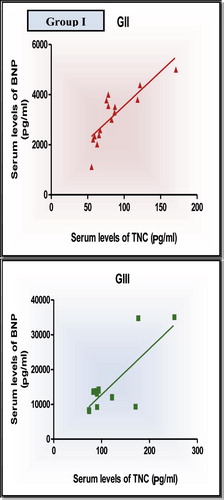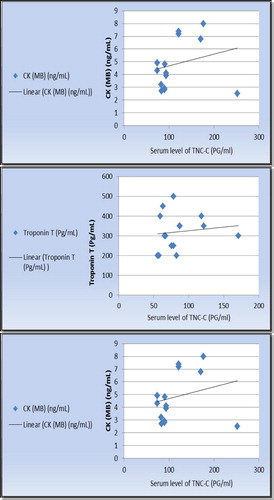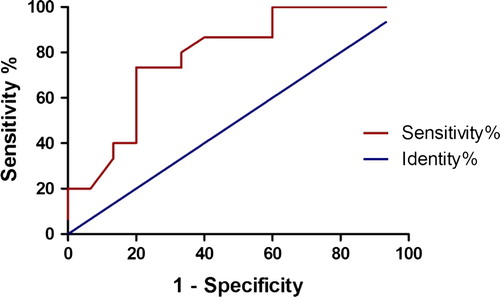Abstract
Background
Myocardial infarction (MI) is defined as myocardial cell necrosis due to significant and sustained ischemia. TN-C is an extracellular matrix glycoprotein that is expressed in several important steps during the very early stage of cardiogenesis. TN-C is not normally expressed in the adult heart, but transiently appears during pathological conditions and plays important roles in tissue remodeling.
Aim
To study the role of TN-C in myocardial infarction patients and to evaluate its role as a predictor of HF in these patients.
Methods
This study was conducted on 45 cases uniformly divided into 3 closely matched (in age and sex) groups as follows: Group (I) includes 15 patients who were suffering from AMI; Group (II) includes 15 patients who were suffering from HF on top of MI; and Group (III) includes 15 healthy volunteers coming for regular annual checkup. 3–6 ml venous blood was collected on the day of admission under complete aseptic conditions and stored at −70 °C until assayed by ELISA.
Results
TN-C levels in the sera of patients with AMI Group (I) were significantly higher than those of healthy volunteers. Moreover, in Group I of AMI, a positive correlation between TN-C level on one side and CK, CK-MB and troponin T level on the other side was found. TN-C levels in the sera of patients with congestive heart failure on top of acute MI Group (II) were significantly higher than those of healthy volunteers. Pro-BNP levels in patients with heart failure Group (II) were significantly higher than those with AMI not complicated with heart failure Group (I). Levels of pro-BNP were also positively correlated with those of TN-C in patients with heart failure on top of AMI Group (II).
Conclusions
Serum TN-C might be a novel marker reflecting active structural remodeling in the myocardium following infarction, with high TN-C levels at acute stages possibly predicting progression of LV remodeling. Also, the incorporation of a combination of serum TN-C and plasma BNP levels may improve risk stratification for congestive heart failure after AMI. Further studies on large scale are needed for more evaluation of TN-C role in HF.
1 Introduction
Myocardial infarction (MI) is defined as myocardial cell necrosis due to significant and sustained ischemia.Citation1
TN-C is an extracellular matrix glycoprotein that is expressed in several important steps during the very early stage of cardiogenesis. At first TN-C is expressed by precardiac mesodermal cells, when they differentiate into cardiomyocytes. Once the cells become differentiated and express sarcomeric proteins, they stop expressing TN-C.Citation2
In normal adult heart, TN-C is not detected in the myocardium except at the chorda tendineae of papillary muscles. But it appears under pathophysiologic conditions during tissue remodeling.Citation3 TN-C loosens the attachment of cardiomyocytes to connective tissues and upregulates expression and activity of matrix metalloproteinasesCitation4 promoting degradation of connective tissue and contributing to LV dilation. Furthermore, TN-C could be also a key regulator in early step of fibrosis, and its elevation may suggest active progression of the fibrosisCitation5. Ventricular remodeling is accompanied by changes of the extracellular matrix, and that several molecules related matrix turnover such as matrix metalloproteinases, and their tissue inhibitors, carboxy-terminal telopeptide of type I collagen, amino-terminal propeptide of types I and III procollagen have received much attention as significant biomarkers in HF. TN-C may be a novel candidate for marker of extracellular matrix remodeling.Citation6
TN-C has many biologic effects, including regulation of cell activity during early stage tissue repair.Citation7 It up-regulates MMP expression in a number of cell types,Citation8 and inhibits strong linkages between cardiomyocytes and connective tissue.Citation9
Therefore excessive amount of TN-C might cause disproportionate MMP activation, which would lead to progressive degradation of connective tissues and slippage of myocytes within the left ventricular wall, finally resulting in left ventricular wall thinning and dilatation.Citation10
On the other hand, TN-C has the potential to promote myocardial repair and prevent ventricular dilatation by recruitment of myofibroblasts and enhancement of collagen fibers contraction. Thus the effects of TN-C on ventricular remodeling are not simple but rather bidirectional.Citation11
The levels of TN-C and its relationship with heart function in patients with ischemic heart disease were unclear, and the prognostic value of TN-C in ischemic cardiomyopathy has not been fully investigated.
The aim of this work was to study the role of serum TN-C in myocardial infarction patients to evaluate its role as a predictor of HF in these patients.
2 Methods
This study was conducted in on 45 cases uniformly divided into 3 closely matched (in age and sex) groups as follows: Group (I) includes 15 patients who were suffering from AMI; and Group (II) includes 15 patients who were suffering from HF diagnosed clinically and EF% of heart failure group was 43 ± 6.
Evaluation done in 1st 24 h after MI.
Group (III) includes 15 healthy volunteers coming for regular annual checkup.
Patients presented with HF due to other causes than MI, chronic renal failure, chronic liver diseases, endocrinal, autoimmune diseases, infection, inflammatory diseases, malignant cancer, severe trauma, surgical intervention within three months were excluded from this study.
| • | All participants have been subjected for the following: | ||||
| A. | Full clinical examination. | ||||
| B. | ECG and Echo-cardiography. | ||||
| C. | Routine laboratory investigations:
| ||||||||||||||||||||||
Pro-BNP: ELISA (measured in pg/ml).Citation14
Tenascin-C: ELISA (measured in pg/ml).Citation15
| • | Sample | ||||
6 ml venous blood was collected on the day of admission under complete aseptic conditions and divided as follows:
3 ml was delivered into plain tube, left for 20 min for coagulation, and centrifuged for 30 min and serum was separated. Aliquots of serum were delivered into Eppendorf tubes. Serum samples have been used for evaluation of cardiac markers (CK, CKMB and Troponin-T), liver function tests (AST and ALT), and CRP.
| – | Serum samples for TN-C and pro-BNP were stored at −70 °C until assayed by ELISA. | ||||
| – | 2 ml was delivered into tubes containing EDTA for complete blood picture. | ||||
ELISA for Determination of TN-CCitation15
A commercial kit manufactured by Glory Science Company (USA).
3 Statistics
Data are presented as means ± SD. (S) is statistically significant difference. P was calculated by one way ANOVA test followed by Turkey’s post-hoc test. P was considered significant at <0.05.
4 Results
Demographic, clinical and echocardiographic data of Groups I and II are summarized in .
Table 1 Demographic, clinical and echocardiographic parameters of HF group and MI without HF group.
The mean value of serum level of TN-C in patients having myocardial infarction of Group (I) was 115.8 ± 49.26 pg/ml which differed statistically from that of control Group (III) which was 52.79 ± 5.325 pg/ml. Also, the mean value of serum level of TN-C in CHF patients of Group (II) 84.47 ± 31.09 pg/ml differed significantly from that of control Group (III). C-reactive protein, liver enzymes and cardiac markers values summarized in –. There was significant difference between the mean values of serum level of TN-C in Group (I) (115.8 ± 49.26) pg/ml and those of Group (II) (84.47 ± 31.09) pg/ml ().
Table 2a C-Reactive protein (CRP) in groups under study.
Table 2b Liver enzymes in groups under study.
Table 2c Cardiac markers in different groups under the study.
Table 3 TN-C levels (pg/ml) and pro-BNP levels (pg/ml) in groups under study.
The mean value of serum level of pro-BNP in patients having myocardial infarction of Group (I) was 3131 ± 1024 pg/ml which differed statistically from that of control Group (III) which was 45.87 ± 12.52 pg/ml. Also, the mean value of serum level of pro-BNP in CHF patients of Group (II) 14863 ± 8393 pg/ml differed significantly from that of control Group (III). Also, there was significant difference between the mean values of serum level of pro-BNP in Group (I) (3131 ± 1024) and those of Group (II) (14863 ± 8393 pg/ml) ().
Correlation between serum BNP and TN-C levels, and cardiac markers among different groups in our study was calculated by linear correlation method. It was found that there was high significant positive correlation between serum BNP and TN-C levels in Groups (I) and (II) of this study ( and , a and b and a–c).
Table 4 Correlation between serum Tenascin-C and pro-BNP levels in different groups of the study.
Table 5 Correlation between serum Tenascin-C and the other cardiac markers.
For evaluating the role of measuring TN-C level for predicting the incidence of heart failure among patients with AMI, the receiver operator characteristics of the values obtained in this current study for patients with AMI and heart failure were calculated and ROC curve was constructed. The cutoff value that gave the closest values for sensitivity and specificity was 82.95 pg/ml which gives 80% for sensitivity and 66.67 for specificity ( and , ).
Table 6 ROC of Tenascin-C as a predictor of heart failure after AMI.
Table 7 AUC and ROC curve values for TN-C as a predictor of emergence of heart failure among patients with AMI.
5 Discussion
Advances in diagnostic technology, including new biomarkers and imaging methods that are more specific and/or sensitive, have enabled the detection of even minor myocardial cell necrosis. These advances called for a re-evaluation of the case definition of MI.Citation16
The present study measured the TN-C levels in the sera of patients with AMI without heart failure (Group I), MI patients complicated by heart failure (Group II) and healthy volunteers (Group III). TN-C levels in the sera of patients with AMI (Group I) and patients with congestive heart failure on top of acute myocardial infarction (Group II) were significantly higher than those of healthy volunteers.
In agreement with our study, Celik et al.Citation17 have stated that TN-C levels were high in patients with myocardial infarction and successful revascularization treatment of patients was associated with decrease in TN-C levels. In the same year, Sato et al.Citation18 noted significantly elevated TN-C levels within 24 h after onset. Levels peaked at day 5 and then gradually decreased, reflecting local expression in the myocardium. They stated that this time course of serum TN-C levels corresponds to local expression of TN-C in infarcted myocardium of rats and humans as detected by immunohistochemistry.
Recently Yang et al.,Citation19 studied the correlation between serum TN-C and level and angiographically demonstrated complex stenosis in patients with ACS and stable angina from registry of coronary angiography cases. The results of this study demonstrated that the TN-C levels increased as clinical severity increased from Stable Angina to ACS and there was a positive correlation between TN-C expression and the number of complex lesions in patients with ACS. The present study differs from Yang et al. study in that the study group only recent MI patients in the 24 h no intervention done before level detection and emphasis mainly on TN-C level to predict heart failure in recent MI.
The positive correlation between serum levels of TN-C and pro-BNP that has been found in the current study can provide evidence that TN-C can be considered as a biomarker of AMI which can reflect the severity of the condition and predict the emergence of left ventricular dilatation and heart failure. This correlation has been also confirmed by Sato et al.Citation20 who demonstrated the presence of a parallel increase of both BNP and TN-C in patients with AMI and added that TN-C could be thus considered as a novel marker for the prediction of ventricular remodeling and prognosis of AMI.
On the other hand, Nishioka et al.Citation21 discovered that in patients who respond well to cardiac resynchronization therapy (CRT) as a line of treatment for CHF, the serum levels of TN-C were significantly reduced over 6 months. Similarly, while angiotensin II induced hypertension in mice and stimulated TN-C expression in fibrotic lesions, treatment with the aldosterone receptor antagonist eplerenone attenuated fibrosis and reduced TN-C expression.
Franz et al.Citation22 reported that TN-C, might qualify as promising novel biomarkers for diagnosis and prognosis of myocardial infarction. BNP has long been considered as a marker of heart failure and left ventricular remodeling.Citation23
In the current study, a positive correlation between TN-C level and troponin T level in Group 1 of patients having acute myocardial infarction was found indicating that circulating TN-C is generally associated with the severity of left ventricular dysfunction. This finding is consistent with the same finding reported by Maisel et al.Citation24
In this study, the serum level of TN-C is positively correlated with the serum level of both CK and CK-MB. This finding was not evident in the study of Mayr et al.Citation25 who found no correlation between TN-C and CK-MB. This may be attributed to the difference of timing of blood samples. In our study, samples were taken early coinciding with the peak level of CK-MB after MI, while in Mayr et al. study, samples were taken after 5 days of ST-elevated MI.
Notes
Peer review under responsibility of Alexandria University Faculty of Medicine.
References
- J.S.AlpertK.ThygesenA new global definition of myocardial infarction for the 21st centuryPol Arch Med Wewn1172007485486
- K.Imanaka-YoshidaK.MatsumotoM.HaraT.SakakuraT.YoshidThe dynamic expression of Tenascin-C and tenascin-X during early heart development in the mouseDifferentiation712003291298
- K.Imanaka-YoshidaM.HiroeY.YasutomiT.ToyozakiT.TsuchiyaN.NodaTenascin-C is a useful marker for disease activity in myocarditisJ Pathol1972002388394
- I.KalembeyiH.InadaR.NishiuraK.Imanaka-YoshidaT.SakakuraT.YoshidaTenascin-C upregulates matrix metalloproteinase-9 in breast cancer cells: direct and synergistic effects with transforming growth factor beta1Int J Cancer10520035360
- T.NishiokaM.SuzukiK.OnishiN.TakakuraH.InadaT.YoshidaEplerenone attenuates myocardial fibrosis in the angiotensin II-induced hypertensive mouse: involvement of Tenascin-C induced by aldosterone-mediated inflammationJ Cardiovasc Pharmacol492007261268
- F.G.SpinaleMyocardial matrix remodeling and the matrix metalloproteinases: influence on cardiac form and functionPhysiol Rev87200712851342
- N.TomaK.Imanaka-YoshidaT.TakeuchiS.MatsushimaH.IwataW.TakiTenascin-C-coated platinum coils for acceleration of organization of cavities and reduction of lumen size in a rat aneurysm modelJ Neurosurg1032005681686
- R.NishiuraN.NodaH.MinouraN.ToyodaK.Imanaka-YoshidaT.SakakuraExpression of matrix metalloproteinase-3 in mouse endometrial stromal cells during early pregnancy: regulation by interleukin-1alpha and tenascin-CGynecol Endocrinol212005111118
- K.Imanaka-YoshidaR.MatsuuraN.IsakaT.NakanoT.SakakuraT.YoshidaSerial extracellular matrix changes in neointimal lesions of human coronary artery after percutaneous transluminal coronary angioplasty: clinical significance of early tenascin-C expressionVirchows Arch4392001185190
- K.Imanaka-YoshidaM.HiroeT.YoshidaInteraction between cell and extracellular matrix in heart disease: multiple roles of tenascin-C in tissue remodelingHistol Histopathol192004517525
- M.TamaokiK.Imanaka-YoshidaK.YokoyamaT.NishiokaH.InadaM.HiroeTenascin-C regulates recruitment of myofibroblasts during tissue repair after myocardial injuryAm J Pathol16720057180
- G.SchumannR.BonoraF.CeriottiP.Clerc-RenaudC.A.FerreroG.FerardIFCC primary reference procedures for the measurement of catalytic activity concentrations of enzymes at 37 degrees C. Part 2. Reference procedure for the measurement of catalytic concentration of creatine kinaseClin Chem Lab Med402002635642
- J.S.AlpertK.ThygesenE.AntmanJ.P.BassandMyocardial infarction redefined – a consensus document of The Joint European Society of Cardiology/American College of Cardiology Committee for the redefinition of myocardial infarctionJ Am Coll Cardiol362000959969
- N.NagayaT.NishikimiY.OkanoM.UematsuT.SatohS.KyotaniPlasma brain natriuretic peptide levels increase in proportion to the extent of right ventricular dysfunction in pulmonary hypertensionJ Am Coll Cardiol311998202208
- F.TerasakiH.OkamotoK.OnishiA.SatoH.ShimomuraB.TsukadaHigher serum tenascin-C levels reflect the severity of heart failure, left ventricular dysfunction and remodeling in patients with dilated cardiomyopathyCirc J712007327330
- R.V.LuepkerF.S.AppleR.H.ChristensonR.S.CrowS.P.FortmannD.GoffCase definitions for acute coronary heart disease in epidemiology and clinical research studies: a statement from the AHA Council on Epidemiology and Prevention; AHA Statistics Committee; World Heart Federation Council on Epidemiology and Prevention; the European Society of Cardiology Working Group on Epidemiology and Prevention; Centers for Disease Control and Prevention; and the National Heart, Lung, and Blood InstituteCirculation108200325432549
- A.CelikN.KalayO.SahinM.DuranH.KorkmazM.A.KobatThe importance of cardiac biomarkers on remodelling after myocardial infarctionJ Clin Med Res420122025
- A.SatoM.HiroeD.AkiyamaH.HikitaT.NozatoT.HoshiPrognostic value of serum tenascin-C levels on long-term outcome after acute myocardial infarctionJ Card Fail182012480486
- J.H.YangF.RenClinical implications of tenascin-C and OX40 ligand in patients with acute coronary syndromeJ Biomed Rep212014132136
- A.SatoK.AonumaK.Imanaka-YoshidaT.YoshidaM.IsobeD.KawaseSerum tenascin-C might be a novel predictor of left ventricular remodeling and prognosis after acute myocardial infarctionJ Am Coll Cardiol47200623192325
- T.NishiokaM.SuzukiK.OnishiN.TakakuraH.InadaT.YoshidaEplerenone attenuates myocardial fibrosis in the angiotensin II-induced hypertensive mouse: involvement of tenascin-C induced by aldosterone-mediated inflammationJ Cardiovasc Pharmacol492007261268
- M.FranzC.JungA.LautenH.R.FigullaA.BerndtTenascin-C in cardiovascular remodeling: potential impact for diagnosis, prognosis estimation and targeted therapyCell Adh Migr920159095
- J.L.JanuzziJr.Natriuretic peptides as biomarkers in heart failureJ Investig Med612013950955
- A.S.MaiselP.KrishnaswamyR.M.NowakJ.McCordJ.E.HollanderP.DucRapid measurement of B-type natriuretic peptide in the emergency diagnosis of heart failureN Engl J Med3472002161167
- A.MayrJ.MairG.KlugM.SchockeK.PedarnigT.TriebCardiac troponin T and creatine kinase predict mid-term infarct size and left ventricular function after acute myocardial infarction: a cardiac MR studyJ Magn Reson Imag332011847854



